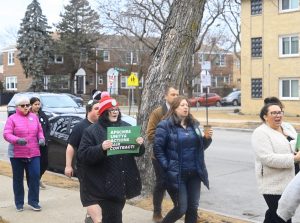The Hookup
September 27, 2017
On Thursday, Sep. 14 NEIU hosted “The Hookup,” an interactive Catharsis Production led by Anthony Dinicola, which looks at dating behaviors and how they can be hiding sexual violence.
“I like to use real language because I like to talk about the subject matter how people really talk about the subject matter,” said Dinicola.
Dinicola did not hold back when addressing the controversial topic of rape. “Rape is a problem,” he said. A statement like this might seem obvious for people, as most can agree that rape is a crime, but the goal of “The Hookup” is to unmask society’s perspectives on dating and what “typical” predatory behavior looks like.
Even people who choose to abstain from sexual activity are not always safe. “That choice goes only as far as your partner’s choices to respect that choice,” said Dinicola.
In the first question asked to the audience, Dinicola pointed out the difference between the words that are used to describe a woman who has multiple sexual partners versus a man who has multiple sexual partners.
Not only was the list of words to describe a woman almost twice the size as the one for the men, but it also contained more aggressive and negative words.
Dinicola was also quick to point out what all the words on the whiteboard had in common: we all have different definitions of what makes up those words.
“There is no such thing as a slut, it’s like a freaking unicorn, it’s made up,” he said.
The point of starting the audience with this exercise was to showcase that language runs rampant.
“People who sexually assault need language and double standards to justify their behavior,” said Dinicola.
As a society, if we control the language and the power we give derogatory connotations regarding human sexual behavior we can change the discussion of not only the sexual predators but also their victims. It is not uncommon for sexual assault victims to be questioned and referred to as “sluts and whores” by others, making it harder to sympathize with their situations.
To break down what can lead to these situations, Dinicola asked the audience to brainstorm what the differences between a “great” hookup and a “bad hookup” were.
“Not all hookups are created equal,” he said.
“Consent” was the first word mentioned under the category of what makes a hookup great and has been largely accepted by society as a standard. But what does consent look like? Consent is verbal, active, and ongoing. As Dinicola clearly stated, the person who is initiating the sexual act must ask every time.
As a college-age group, the next scenario brought up in “The Hookup” can be relatable. The scenario included parties or other gatherings where alcohol is present. Also on the list for things that would make a hook up bad is being under the influence of any substance, including alcohol. Ninety percent of the time, the drug that is used in cases of rape is alcohol, as it is legal and easily accessible.
These scenarios often included similar warning signs for both the victim and the aggressor. The victim can seem highly intoxicated, with slurred speech and uncoordinated movements, while the aggressor, for the most part, remains sober in order to maintain control of the situation.
“We have to stop thinking that it is just a drunk hookup,” Dinicola said.
It is also crucial to remember that not every aggressor is a stranger, as 78 percent of rape is non-stranger rape. “We are taught to punch and kick and scream to the person who grabs us in the dark ally, not the person from chem class,” he said.
Recently, high-profile cases of rape have allowed for a large audience to understand this topic and change the perception we have of who commits rape. Brock Turner, a former Stanford swimmer, made national headlines last year for sexually assaulting an unconscious Emily Doe near a dumpster outside a fraternity party in January 2015.
While Turner’s case was met with criticism due to the sentence he was served and raised questions in the treatment of sexual assault victims, it has helped change the image of the “stereotypical rapist.”
While “The Hookup” talked about perpetrators of sexual assault crimes, it did not fail to mention how we can help victims. “The biggest thing that can help is if the first person they speak to meets them with support,” said Dinicola. “They think ‘I have someone who has my back’ and that is an amazing moment.”
In this new hookup culture our society is currently living in, it is important to understand how we can make a difference and change the outcome of a situation, or as Dinicola put it “the power we have on the outside.”
In situations where we see someone who we believe is in potential danger of becoming a victim, it is important for us to intervene. While the idea of walking into a confrontational situation can be scary, Dinicola delivered ways to intervene by remembering the 4 D’s; direct, distract, delegate, and delayed.
When dealing with a heavy topic such as sexual assault, interactive programs such as “The Hookup” offered an entertaining way to address an issue that can affect many college campuses.
NEIU, aware of the importance of having these conversations with students, made sure to offer information on how students can access resources if need be. Rae Joyce Baguilat, one of the confidential advisors on campus, made Student Health pamphlets available for those who might need them.
“We want to make sure that people have resources, that everyone knows where the health services,” she said. “We know that if there are students who have been sexually assaulted they might not know where to go so they go unreported.”
With one in five women and one in 33 men being victims of sexual assault, it is important to take the message of “The Hookup” and learn to decipher appropriate dating behavior from potentially dangerous behavior.







